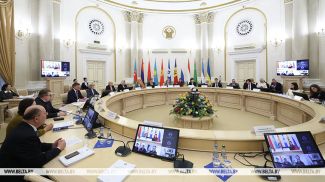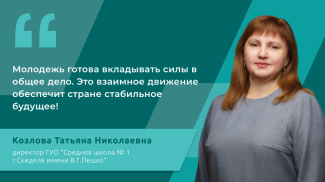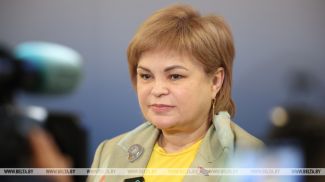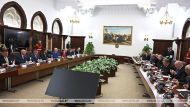During the first day of Operation Bagration, Germany's Group Army Center suffered a catastrophic defeat at the hands of the Soviet Army. Most of the divisions of this army group were encircled and exterminated.
The developments in Belarus enraged Hitler. On 28 June Commander of Army Group Center Field Marshal Ernst Busch was sacked and replaced by Field Marshal Walter Model. The new commander decided to establish defenses and stem the Soviet advance east of Minsk. The security and special-purpose units from Army Group North and Army Group North Ukraine were dispatched to Minsk to reinforce Army Group Center. However the effort was not enough to slow the Soviet advance. The Soviet troops bypassed enemy strongholds via forests and marshes and kept advancing on Minsk, Slutsk and Molodechno.
Decisive battles took place in the axis of advance of the 3rd Belarusian Front on the Berezina River near Borisov. In 1812 this river witnessed the demise of the Napoleonic Army. The Wehrmacht was about to have the same fate here in 1944. On the night of 1 July the Soviet Army smashed its way into Borisov and liberated the town by dawn. Thirteen units and formations that made the biggest contribution to the liberation of the town were granted the honorary title “Borisov”.
The steady Soviet advance resulted in the liberation of Begoml District, Sharkovshchina District, Gresk District and Borisov District on 1 July and Plissa District, Dokshitsy District, Starobin District, Smolevichi District, Logoisk District, Cherven District, Kurenets District and Stolbtsy District on 2 July. During the Minsk operation, the 2nd Belarusian Front and the 1st Belarusian Front freed Cherven and Stolbtsy.
Belarusian partisans were of great help to the Red Army building on the pressure on Germany troops. For the first time during the Great Patriotic War the partisans managed to establish steady communication with the army. The partisans attacked enemy communications, robbed the German troops of reinforcements, weapons and ammunition, and ambushed the Nazi troops.
The rapid advance of the Red Army was in many ways due to tank armies. The 4th guards tank brigade (Lieutenant Colonel O. Losik) of the 2nd guards tank corps rushed westwards through forests and marshes leaving the enemy troops more than 100km behind. On the night of 3 July the brigade dashed into Minsk highway and soon burst into the northeastern part of the city. The 5th guards tank army soon smashed their way into the city.
The tank armies soon linked up with the 11th guards army and the 31st army of the 3rd Belarusian Front. They engaged in a house-to-house fighting and started forcing the Germans back. By the midday of 3 July the 1st guards tank corps and the 3rd army of the 1st Belarusian Front entered the city from the southeast. Late at night on 3 July 1944 the Belarusian capital was liberated from the German invaders.
Fifty-two units and formations that made the biggest contribution to the liberation of the city were granted the honorary title “Minsk”. Twenty-four salvos from 324 cannons celebrated the liberation of the capital of Belarus in Moscow. The 2nd guards tank corps and the 4th guards tank brigade were awarded the Order of the Red Banner. In recognition of the feats of arms accomplished during the liberation of Minsk and the oblast the Hero of the Soviet Union title was given to 16 tankmen. A tank of the 4th guards tank brigade was mounted on the pedestal in the Minsk downtown.
On 3 July the Red Army liberated Glubokoye, Pukhovichi, Berezino, Radoshkovichi and Ostrovets districts.
A large group of German troops was encircled near Minsk into the “Minsk pocket”. It was destroyed by 11 July by the troops of the 2nd Belarusian Front and the 31st army of the 3rd Belarusian Front. The “Minsk pocket” held nearly 105,000 Nazis. For the first time during the offensive of the Red Army, the enemy was surrounded and destroyed as a result of the parallel and frontal advancement 200-250km into the enemy rear. The 31st army under the command of General V. Kryuchenkin played a crucial role in the final stage of the elimination of the "Minsk pocket".
Fierce battles for Polotsk lasted for 4 days. The Soviet Information Bureau reported: "On the outskirts of the town, the enemy built a deeply echeloned defensive line known as the “Tiger”. In the town itself, the Germans built a large number of durable fire positions using stone buildings for this purpose. Our troops broke through the Tiger line, destroyed the inner boundaries of the Polotsk fortified district and started fighting in the streets of the town. The Germans frantically fought back. Our soldiers drove the Germans out of cellars, houses, dugouts and bunkers. The fighting continued all night. In the battles for Polotsk the Nazis suffered enormous losses in men and equipment.” During the Polotsk operation the troops of the 1st Baltic Front liberated the town on 4 July. 31 units and formations that made the biggest contribution to the liberation of the town were awarded the honorary title "Polotsk". On the same day the Red Army liberated the Dunilovichi, Disna, Miory, Kletsk, Zaslavl, Rudensk, Uzda, Krivichi, Myadel and Nesvizh districts.
Lyakhovichi, Smorgon, Volozhin, Turov and Postavy districts were liberated on 5 July. During the Vilnius operation the troops of the 3rd Belarusian Front liberated the town of Molodechno. 13 units and formations that made the biggest contribution to the liberation of the town were awarded the honorary title "Molodechno".
On 6 July the Red Army liberated Zhitkovichi, Ivenets, Dzerzhinsk, Braslav, Lenino and Svir districts and on 7 July Oshmyany, Yuratishki, Mir, Stolin and Gantsevichi districts.
On 8 July during the Bialystok operation the troops of the 2nd Belarusian Front liberated the town of Novogrudok. During the advance on Baranovichi and Slonim the 1st Belarusian Front liberated the district center of Baranovichi. 28 units and formations that that made the biggest contribution to the liberation of the town were awarded the honorary title "Baranovichi". The Soviet troops liberated Vidzy, Lyubcha, Ivie, Korelichi, Novogrudok, Novaya Mysh, and Gorodishche districts.
During the Vilnius operation on 9 July the troops of the 3rd Belarusian Front liberated the town of Lida. Four units and formations that made the key contribution to the liberation of the city were given honorary title “Lida”. Dyatlovo and David-Gorodok Districts were liberated as well.
The areas liberated on 10-15 July included Slonim, Byten, Luninets, Telekhany, Voronovo, Kossovo, Drissa, Rossony, Vasilishki, Zheludok, Zelva, Mosty, Shchuchin, Kozlovshchina, Radun, Ruzhany, Volkovysk, Skidel, Porozovo, Logishin and Bereza districts.
During the offensive in the Baranovichi-Brest direction the 1st Belarusian Front with the support from the Dnieper River fleet took the town of Pinsk by assault on 14 July. The landing forces entered the town from the south at night to engage into street fighting with the enemy's garrison. Meanwhile, the Soviet troops crossed the Yaselda and Pripyat rivers to break into the town from the opposite sides. 18 distinguished units and formations that made the biggest contribution to the liberation of the town were given the honorary title “Pinsk”.
On 5-16 July the Soviet troops chased the retreating units of the enemy, destroying their rearguards and repulsing counterattacks. On 8 July the troops of the 3rd army took over the town of Novogrudok. By late 9 July they reached the Neman and Molchad rivers, making the 120-125km advancement in a span of five days. The troops of the 50th army joined the battles on 10 July and reached the Svisloch and Neman rivers by 16 July. Having crossed the rivers they liberated the city of Grodno (the right part of the city on 16 July, the areas behind the Neman by 24 July). The honorary title “Grodno” was bestowed upon the units and formations that played a leading role in the liberation of the city. Zhabchitsy, Pruzhany, Ivanovo, Antopol districts were liberated on 16 July.
On 17-28 July the Soviet troops liberated Osveya, Berestovitsa, Svisloch, Shereshevo, Drogichin, Sopotskin, Zhabinka, Kobrin, Malorita, Divin, Kamenets, Domachevo and Vysokovsk districts.
On 28 July during the Lublin-Brest offensive the 70th army crossed the Western Bug River to enter the city of Brest from the southwest. The 28th army approached the Western Bug northwest of Brest cutting off the getaway route for the enemy. On 28 July the troops of the 61st army with the assistance of the 70th and 28th armies liberated Brest. Forty-seven units and formations that made the biggest contribution to the liberation of the city got the honorary title “Brest”.
The liberation of Brest marked the end of the liberation of Belarus. By the end of July Belarus was completely cleared from the Hitler's forces. A start was given to the liberation of Lithuania, Latvia and Poland. Operation Bagration resulted in the movement of the frontline 600km westward.
Armies led by Generals P.B atov, A. Beloborodov, V. Glagolev, A. Gorbatov, I. Lyudnikov, P. Rotmistrov, S. Rudenko, T. Khryukin, I. Chistyakov and others distinguished themselves in the liberation of Belarus.
Many units were led by Belarusian Generals A. Blagoveshchensky (2nd fighter aircraft corps), A. Boreiko (9th guards rifle corps), V. Dobrovolsky (16th rifle corps), A. Karovatsky (3rd separate army corps), A. Lyukhtikov (60th rifle corps), N. Multan (69th rifle corps), F. Perkhorovich (3rd guards rifle corps), I. Ragulya (80th rifle corps), A. Tereshkov (38th rifle corps), V. Urbanovich (41st rifle corps), Y. Fominykh (25th tank corps), etc.
Army headquarters were led by Belarusian Generals V. Penkovsky (6th guards army), A. Pulko-Dmitriyev (61st army), G. Sidorovich (5th tank army), M. Siminovsky (39th army). Divisions were led by Belarusians A. Vladychansky, V. Vuss, G. Isakov, G. Kulyako, Y. Marchenko, I. Obushenko, A. Pastrevich, I. Pisarev, N. Ruban, I. Sankovsky, G. Sinitsyn, A. Slits, P. Tolstikov, F. Shiroky, V. Shkel and others.
The defeat of the Nazis in Belarus was one of the most important battles in the Second World War and the Great Patriotic War. Many historians consider it as a catastrophe for the Wehrmacht. Others say that it meant a complete defeat of the Nazis. Indeed, in 1944 the German army lost more soldiers than it did on the Volga River, in Stalingrad. Over 381,000 enemy soldiers, officers and generals were killed and 158,000 Nazis were taken prisoners in Belarus.
For incredible heroism displayed in the liberation of Belarus 1,687 people, including 39 Belarusians, were awarded the Hero of the Soviet Union title. More than 20 soldiers in Belarus repeated the feat of Alexander Matrosov; over 10 pilots rammed enemy aircraft and about 30 pilots repeated the feat of Nikolai Gastello; 874 units were decorated with orders, 747 formations received honor titles after the Belarusian towns they liberated; over 100 Heroes of the Soviet Union became honorary residents of Belarusian towns. Commander of the 65th army General P. Batov received this title in seven towns which were liberated by his soldiers. These are Baranovichi, Bobruisk, Kalinkovichi, Loyev, Rechitsa, Svetlogorsk, and Slonim.
Belarus remembers and honors its liberators. During the Great Patriotic War Belarus lost millions of its citizens. About 1.3 million Belarusians fought on the frontline. Partisans and underground fighters made a big contribution to the defeat of the Nazis. Within three years of the heroic fight in the rear of the enemy Belarus' patriots killed about 500,000 Nazi soldiers and policemen. The input of the Belarusian nation in the Great Victory and the defeat of fascism was acknowledged all over the world.
The developments in Belarus enraged Hitler. On 28 June Commander of Army Group Center Field Marshal Ernst Busch was sacked and replaced by Field Marshal Walter Model. The new commander decided to establish defenses and stem the Soviet advance east of Minsk. The security and special-purpose units from Army Group North and Army Group North Ukraine were dispatched to Minsk to reinforce Army Group Center. However the effort was not enough to slow the Soviet advance. The Soviet troops bypassed enemy strongholds via forests and marshes and kept advancing on Minsk, Slutsk and Molodechno.
Decisive battles took place in the axis of advance of the 3rd Belarusian Front on the Berezina River near Borisov. In 1812 this river witnessed the demise of the Napoleonic Army. The Wehrmacht was about to have the same fate here in 1944. On the night of 1 July the Soviet Army smashed its way into Borisov and liberated the town by dawn. Thirteen units and formations that made the biggest contribution to the liberation of the town were granted the honorary title “Borisov”.
The steady Soviet advance resulted in the liberation of Begoml District, Sharkovshchina District, Gresk District and Borisov District on 1 July and Plissa District, Dokshitsy District, Starobin District, Smolevichi District, Logoisk District, Cherven District, Kurenets District and Stolbtsy District on 2 July. During the Minsk operation, the 2nd Belarusian Front and the 1st Belarusian Front freed Cherven and Stolbtsy.
Belarusian partisans were of great help to the Red Army building on the pressure on Germany troops. For the first time during the Great Patriotic War the partisans managed to establish steady communication with the army. The partisans attacked enemy communications, robbed the German troops of reinforcements, weapons and ammunition, and ambushed the Nazi troops.
The rapid advance of the Red Army was in many ways due to tank armies. The 4th guards tank brigade (Lieutenant Colonel O. Losik) of the 2nd guards tank corps rushed westwards through forests and marshes leaving the enemy troops more than 100km behind. On the night of 3 July the brigade dashed into Minsk highway and soon burst into the northeastern part of the city. The 5th guards tank army soon smashed their way into the city.
The tank armies soon linked up with the 11th guards army and the 31st army of the 3rd Belarusian Front. They engaged in a house-to-house fighting and started forcing the Germans back. By the midday of 3 July the 1st guards tank corps and the 3rd army of the 1st Belarusian Front entered the city from the southeast. Late at night on 3 July 1944 the Belarusian capital was liberated from the German invaders.
Fifty-two units and formations that made the biggest contribution to the liberation of the city were granted the honorary title “Minsk”. Twenty-four salvos from 324 cannons celebrated the liberation of the capital of Belarus in Moscow. The 2nd guards tank corps and the 4th guards tank brigade were awarded the Order of the Red Banner. In recognition of the feats of arms accomplished during the liberation of Minsk and the oblast the Hero of the Soviet Union title was given to 16 tankmen. A tank of the 4th guards tank brigade was mounted on the pedestal in the Minsk downtown.
On 3 July the Red Army liberated Glubokoye, Pukhovichi, Berezino, Radoshkovichi and Ostrovets districts.
A large group of German troops was encircled near Minsk into the “Minsk pocket”. It was destroyed by 11 July by the troops of the 2nd Belarusian Front and the 31st army of the 3rd Belarusian Front. The “Minsk pocket” held nearly 105,000 Nazis. For the first time during the offensive of the Red Army, the enemy was surrounded and destroyed as a result of the parallel and frontal advancement 200-250km into the enemy rear. The 31st army under the command of General V. Kryuchenkin played a crucial role in the final stage of the elimination of the "Minsk pocket".
Fierce battles for Polotsk lasted for 4 days. The Soviet Information Bureau reported: "On the outskirts of the town, the enemy built a deeply echeloned defensive line known as the “Tiger”. In the town itself, the Germans built a large number of durable fire positions using stone buildings for this purpose. Our troops broke through the Tiger line, destroyed the inner boundaries of the Polotsk fortified district and started fighting in the streets of the town. The Germans frantically fought back. Our soldiers drove the Germans out of cellars, houses, dugouts and bunkers. The fighting continued all night. In the battles for Polotsk the Nazis suffered enormous losses in men and equipment.” During the Polotsk operation the troops of the 1st Baltic Front liberated the town on 4 July. 31 units and formations that made the biggest contribution to the liberation of the town were awarded the honorary title "Polotsk". On the same day the Red Army liberated the Dunilovichi, Disna, Miory, Kletsk, Zaslavl, Rudensk, Uzda, Krivichi, Myadel and Nesvizh districts.
Lyakhovichi, Smorgon, Volozhin, Turov and Postavy districts were liberated on 5 July. During the Vilnius operation the troops of the 3rd Belarusian Front liberated the town of Molodechno. 13 units and formations that made the biggest contribution to the liberation of the town were awarded the honorary title "Molodechno".
On 6 July the Red Army liberated Zhitkovichi, Ivenets, Dzerzhinsk, Braslav, Lenino and Svir districts and on 7 July Oshmyany, Yuratishki, Mir, Stolin and Gantsevichi districts.
On 8 July during the Bialystok operation the troops of the 2nd Belarusian Front liberated the town of Novogrudok. During the advance on Baranovichi and Slonim the 1st Belarusian Front liberated the district center of Baranovichi. 28 units and formations that that made the biggest contribution to the liberation of the town were awarded the honorary title "Baranovichi". The Soviet troops liberated Vidzy, Lyubcha, Ivie, Korelichi, Novogrudok, Novaya Mysh, and Gorodishche districts.
During the Vilnius operation on 9 July the troops of the 3rd Belarusian Front liberated the town of Lida. Four units and formations that made the key contribution to the liberation of the city were given honorary title “Lida”. Dyatlovo and David-Gorodok Districts were liberated as well.
The areas liberated on 10-15 July included Slonim, Byten, Luninets, Telekhany, Voronovo, Kossovo, Drissa, Rossony, Vasilishki, Zheludok, Zelva, Mosty, Shchuchin, Kozlovshchina, Radun, Ruzhany, Volkovysk, Skidel, Porozovo, Logishin and Bereza districts.
During the offensive in the Baranovichi-Brest direction the 1st Belarusian Front with the support from the Dnieper River fleet took the town of Pinsk by assault on 14 July. The landing forces entered the town from the south at night to engage into street fighting with the enemy's garrison. Meanwhile, the Soviet troops crossed the Yaselda and Pripyat rivers to break into the town from the opposite sides. 18 distinguished units and formations that made the biggest contribution to the liberation of the town were given the honorary title “Pinsk”.
On 5-16 July the Soviet troops chased the retreating units of the enemy, destroying their rearguards and repulsing counterattacks. On 8 July the troops of the 3rd army took over the town of Novogrudok. By late 9 July they reached the Neman and Molchad rivers, making the 120-125km advancement in a span of five days. The troops of the 50th army joined the battles on 10 July and reached the Svisloch and Neman rivers by 16 July. Having crossed the rivers they liberated the city of Grodno (the right part of the city on 16 July, the areas behind the Neman by 24 July). The honorary title “Grodno” was bestowed upon the units and formations that played a leading role in the liberation of the city. Zhabchitsy, Pruzhany, Ivanovo, Antopol districts were liberated on 16 July.
On 17-28 July the Soviet troops liberated Osveya, Berestovitsa, Svisloch, Shereshevo, Drogichin, Sopotskin, Zhabinka, Kobrin, Malorita, Divin, Kamenets, Domachevo and Vysokovsk districts.
On 28 July during the Lublin-Brest offensive the 70th army crossed the Western Bug River to enter the city of Brest from the southwest. The 28th army approached the Western Bug northwest of Brest cutting off the getaway route for the enemy. On 28 July the troops of the 61st army with the assistance of the 70th and 28th armies liberated Brest. Forty-seven units and formations that made the biggest contribution to the liberation of the city got the honorary title “Brest”.
The liberation of Brest marked the end of the liberation of Belarus. By the end of July Belarus was completely cleared from the Hitler's forces. A start was given to the liberation of Lithuania, Latvia and Poland. Operation Bagration resulted in the movement of the frontline 600km westward.
Armies led by Generals P.B atov, A. Beloborodov, V. Glagolev, A. Gorbatov, I. Lyudnikov, P. Rotmistrov, S. Rudenko, T. Khryukin, I. Chistyakov and others distinguished themselves in the liberation of Belarus.
Many units were led by Belarusian Generals A. Blagoveshchensky (2nd fighter aircraft corps), A. Boreiko (9th guards rifle corps), V. Dobrovolsky (16th rifle corps), A. Karovatsky (3rd separate army corps), A. Lyukhtikov (60th rifle corps), N. Multan (69th rifle corps), F. Perkhorovich (3rd guards rifle corps), I. Ragulya (80th rifle corps), A. Tereshkov (38th rifle corps), V. Urbanovich (41st rifle corps), Y. Fominykh (25th tank corps), etc.
Army headquarters were led by Belarusian Generals V. Penkovsky (6th guards army), A. Pulko-Dmitriyev (61st army), G. Sidorovich (5th tank army), M. Siminovsky (39th army). Divisions were led by Belarusians A. Vladychansky, V. Vuss, G. Isakov, G. Kulyako, Y. Marchenko, I. Obushenko, A. Pastrevich, I. Pisarev, N. Ruban, I. Sankovsky, G. Sinitsyn, A. Slits, P. Tolstikov, F. Shiroky, V. Shkel and others.
The defeat of the Nazis in Belarus was one of the most important battles in the Second World War and the Great Patriotic War. Many historians consider it as a catastrophe for the Wehrmacht. Others say that it meant a complete defeat of the Nazis. Indeed, in 1944 the German army lost more soldiers than it did on the Volga River, in Stalingrad. Over 381,000 enemy soldiers, officers and generals were killed and 158,000 Nazis were taken prisoners in Belarus.
For incredible heroism displayed in the liberation of Belarus 1,687 people, including 39 Belarusians, were awarded the Hero of the Soviet Union title. More than 20 soldiers in Belarus repeated the feat of Alexander Matrosov; over 10 pilots rammed enemy aircraft and about 30 pilots repeated the feat of Nikolai Gastello; 874 units were decorated with orders, 747 formations received honor titles after the Belarusian towns they liberated; over 100 Heroes of the Soviet Union became honorary residents of Belarusian towns. Commander of the 65th army General P. Batov received this title in seven towns which were liberated by his soldiers. These are Baranovichi, Bobruisk, Kalinkovichi, Loyev, Rechitsa, Svetlogorsk, and Slonim.
Belarus remembers and honors its liberators. During the Great Patriotic War Belarus lost millions of its citizens. About 1.3 million Belarusians fought on the frontline. Partisans and underground fighters made a big contribution to the defeat of the Nazis. Within three years of the heroic fight in the rear of the enemy Belarus' patriots killed about 500,000 Nazi soldiers and policemen. The input of the Belarusian nation in the Great Victory and the defeat of fascism was acknowledged all over the world.













